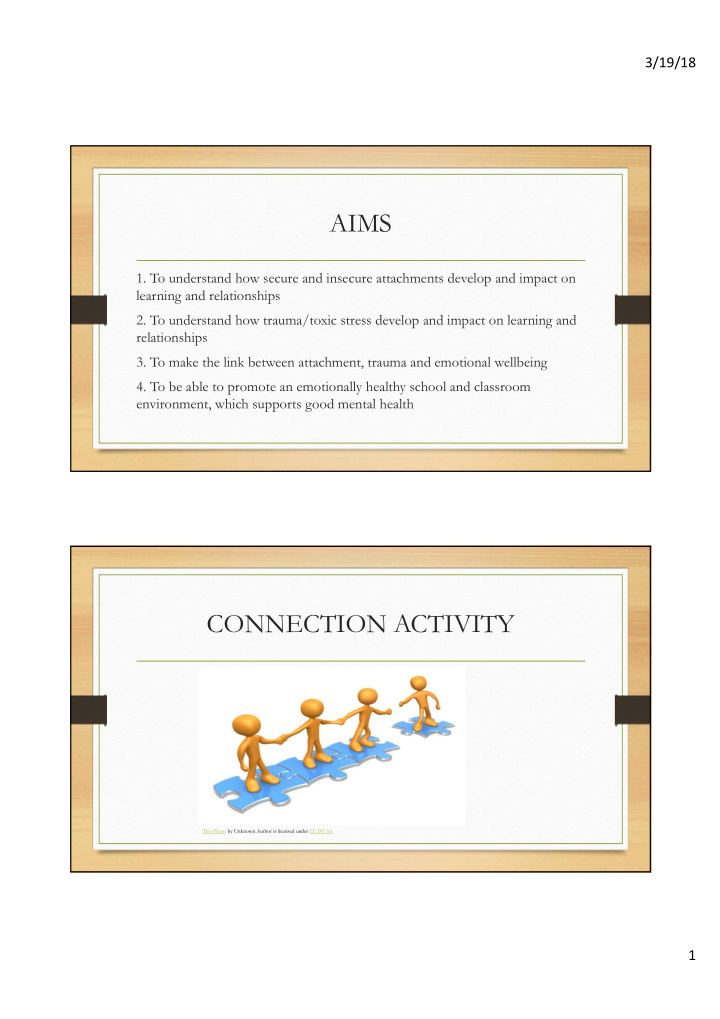



3/19/18 AIMS 1. To understand how secure and insecure attachments develop and impact on learning and relationships 2. To understand how trauma/toxic stress develop and impact on learning and relationships 3. To make the link between attachment, trauma and emotional wellbeing 4. To be able to promote an emotionally healthy school and classroom environment, which supports good mental health CONNECTION ACTIVITY This Photo by Unknown Author is licensed under CC BY-SA 1
3/19/18 Attachment – the circle of security • Activity & Discussion STILL FACE EXPERIMENT https://www.youtube.com/watch?v=apzXGEbZht0 2
3/19/18 What do these children need to engage in learning? Pupil • Heather Geddes Teacher Task DISORGANISED ATTACHMENT 3
3/19/18 Attachment – what about the adults? This Photo by Unknown Author is licensed under CC BY-SA “ The interaction between the teacher, the pupil and the learning task is a fluid dynamic whereby the task is a reflection of the teacher’s awareness and understanding of the pupil and the pupil is able to seek reliable support when challenged by the task. Each relates to the other in a way that fosters curiosity and supports the uncertainty that can be created by the challenges of ‘not knowing’ which is at the heart of all learning .” (Geddes 2006; also Beckes and Coan 2011) 4
3/19/18 Toxic Stress = Trauma • Research shows that brains work best when people feel safe • The key to optimal brain function lies in regulation of stress hormones • Brains develop in response to challenge • The brain enables us to process and make sense of experience • Challenge leads to the production of stress hormones • Healthy if regulated, toxic if unregulated • Toxic stress closes down key brain functions • When brain function closes down people cannot learn well • Humans are not born able to regulate stress • Attachment relationships with adults are essential for children Toxic stress derails healthy development Centre on the Developing Child – Harvard University http://developingchild.harvard.edu/resources/three-core-concepts-in-early-development/ T https://www.youtube.com/watch?v=rVwFkcOZHJw 5
3/19/18 Hand model courtesy of Dan Siegel Impairments of function after toxic stress Until they recover people affected by toxic stress struggle to: • Self-regulate – stress, impulses, shame • Process information accurately – make sense of the world around them or their own internal world of feelings • Make and maintain relationships – understand and be interested in the world of others For children, these difficulties have an impact on the ability to learn and the ability to manage school In addition, those who live and work with the traumatised person may be affected by secondary trauma • Attitudes and behaviour may change • The network around the traumatised child may disintegrate • WHAT BEHAVIOURS WILL WE SEE FROM THE CHILDREN & ADULTS IN A SCHOOL ENVIRONMENT? 6
3/19/18 Promoting recovery from toxic stress and developing emotional regulation Most people most of the time recover from traumatic life events, and this increases resilience There are three phases in this recovery • Not a sequence, but a repetitive relationship-based process • Stabilisation • Feeling safe, feeling emotionally supported, feeling understood • Integration • Self-regulation, emotional processing, coherent accurate narrative • Adaptation • Social responsiveness, joy in living, self-esteem KCA Needs & Interventions Model Recovery Phase Need Indicator Intervention Level – all three levels needed at each stage of recovery Outcomes Indicator Physiological Social & Emotional Cognitive STABILISATION Evident disorder: Establishing safety Identifying words for Recognising trauma Feel safe, supported and hyperarousal or feelings understood dissociation INTEGRATION Stabilised and looking for Teaching Physiological Enabling emotional Enabling cognitive Self-regulation, emotional help to recover self-management processing restructuring literacy, accurate and coherent narrative ADAPTATION Looking to establish life Teaching social Enabling the development Building self-esteem Social responsiveness, joy after trauma responsiveness of the capacity for joy in living, self-esteem 7
3/19/18 Emotion Coaching The brain is shaped by social experience and strengthened by repetition § The social and emotional brain develops in childhood through relationships with attuned, co-regulating adults § Social and emotional functionality drive (and limit) cognitive learning Emotion coaching promotes healthy brain developmeent while dealing with behaviour in the moment § Activates the vagus nerve § Triggers positive mirror neuron activity § Provides a narrative for connecting feeling, thinking and behaving Emotion Coaching – The Process 8
3/19/18 EMOTION COACHING Communication Styles Look after your own emotion well-being Having emotional awareness of own emotions (meta-emotion philosophy) “Put on your oxygen mask first before putting it on the child” Recognising the power and purpose of emotions Empathising Active listening / rapport building Scaffolding / problem solving Role-modelling 9
3/19/18 EVIDENCE 10
Recommend
More recommend